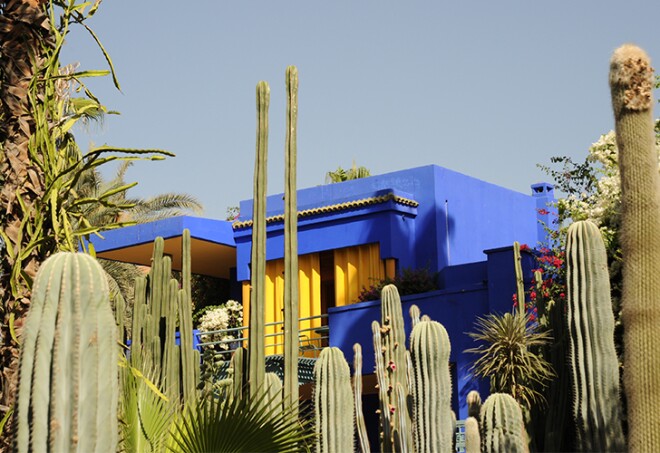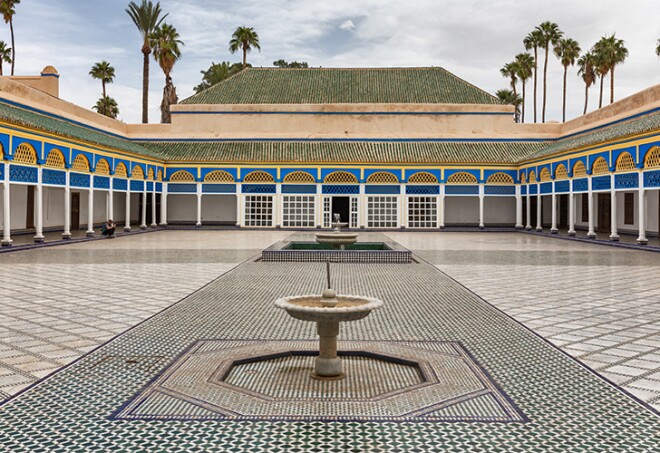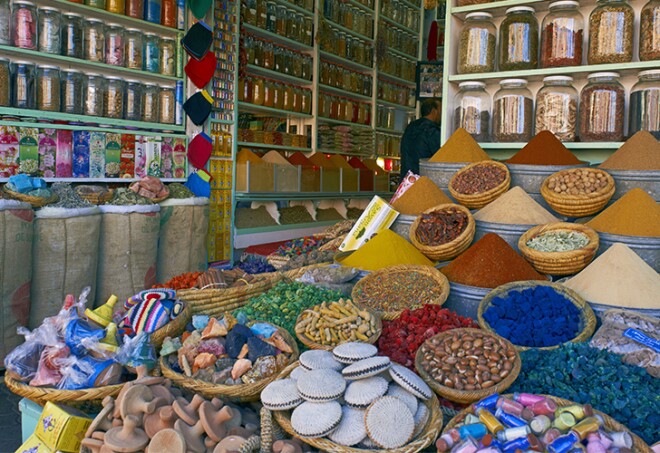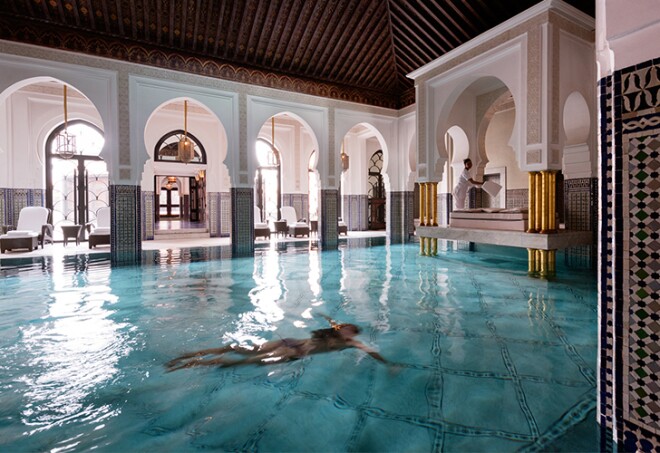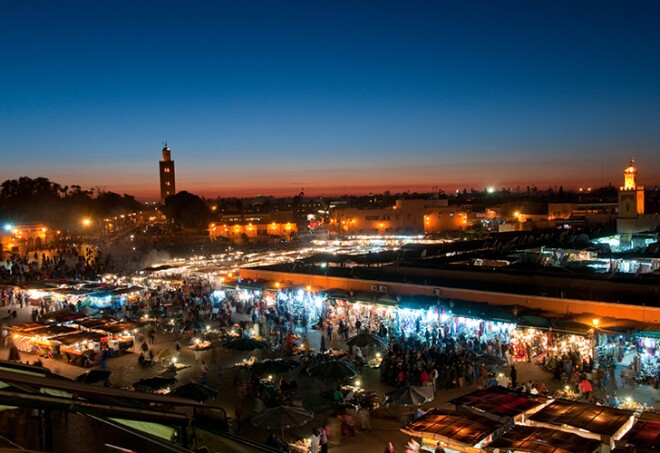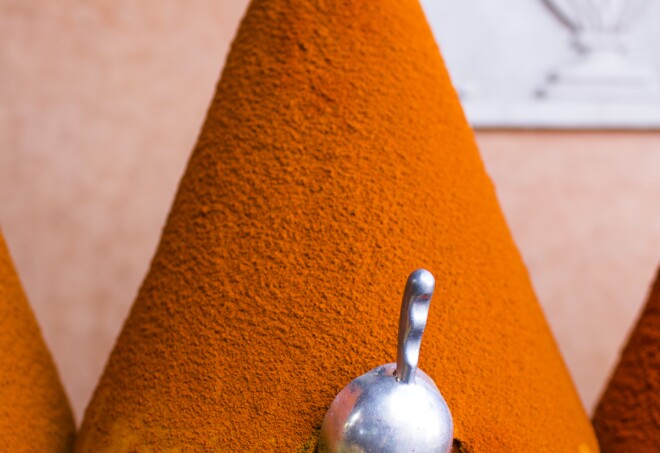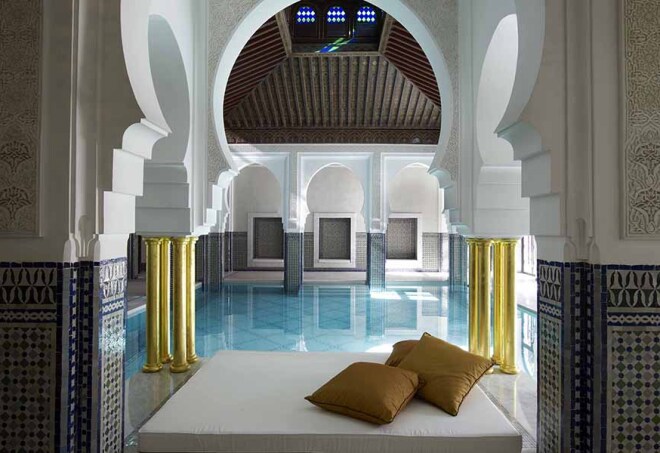The Perfect Weekend in Marrakech
A weekend in Marrakech offers just enough time to take in the Red City’s gardens, the medina, and to tumble through the city’s souks and boutiques, your arms filled with purchases. Of course, the food: from traditional Moroccan dishes to European-inspired meals, and plenty of local red wine. Don’t miss a night of food stalls and snake charmers at Djemma el Fna. Tempting as it may be to stay put in Marrakech’s oldest section for the weekend, leave the medina to tour the stunning gardens French painter Jacques Majorelle left behind, and the museum dedicated to legendary fashion designer Yves Saint Laurent. And do go to a hammam on day one because, really, you’ll quickly see why it should be your daily habit while in town.
Rue Yves St Laurent By A-Maps، Marrakech 40000, Morocco
In 1923, the artist Jacques Majorelle acquired a four-acre plot of land just outside the center of Marrakech. Inspired by numerous travels around the country to paint scenes of village life, and funded by painting more illustrious portraits such as that of Pasha Thami el Glaoui, Majorelle was able to build a small studio and house, with enough land to indulge his other passion: ethnobotany. As his career grew, he added a splendid villa, and the garden took on a life of its own, featuring innumerable exotic species from around the world; he added pools and fountains, and, of course, the now iconic, eye-popping Majorelle blue that was lavished on the architecture. The property became so expensive to maintain that the artist was forced to open it to the public until his death in Paris in 1962. The garden gradually fell into a state of disrepair and was slated for development by a hotel chain until French designer Yves Saint Laurent and his partner Pierre Bergé happened upon it during one of their many trips to the Red City. In 1980, they decided to buy it and restore it to its former glory, adding irrigation and doubling the number of plants and gardeners to look after it. They moved into the villa and set about transforming other buildings into what is now the legendary Berber Museum and a boutique. The latter is especially noteworthy for creative director Stephen di Renza’s commitment to reflecting Majorelle’s lesser-known passion for the decorative arts (which is manifest in the exquisite artisanal pieces, leather goods, and jewelry) and Saint Laurent’s inspired use of traditional Moroccan dress, such as the kaftan and djellaba, in haute couture fashion.
Marrakesh, Morocco
Inscribed above the door of the Ben Youssef Medersa in Marrakech reads the following: “You Who Enter My Door May Your Highest Hopes Be Exceeded.” It is an appropriate proclamation for what is arguably the most mind-blowing example of Islamic design and architecture within a Koranic school anywhere in the country. Founded in the 14th century, it was embellished by the Saadian dynasty in 1570 with an ornate bronze doorway, elegant stuccoes, and a marble-tiled patio lined with elaborate mosaics. The prayer room, with its palm and pine cone motifs, looks down into the courtyard from the students’ quarters and gives a splendid helicopter view of the space. During its heyday, the medersa had room for up to 900 students; it was given over to the city as a museum in the 1960s and has remained so ever since.
Avenue Imam El Ghazali
Surely one of the most extraordinary imperial relics of Morocco, the Palais Bahia (“the brilliant”) doesn’t disappoint. Built at the start of the 19th century by architect El Mekki for Si Moussa, the then chamberlain of Sultan Hassan I, the palace showcases a wide range of architectural styles hinting at the chamberlain’s playful spirit, especially after his son inherited it and added his own brand of flamboyant glamour to the place. Women’s quarters bedecked with crimson-and-mustard–striped ceilings, a marble-tile courtyard the size of a soccer field, and extensive salons lined by stained-glass windows are just some of the features of the 20-acre space. In 1912, General Lyautey, the governor of French protectorate Morocco, moved in and added creature comforts such as fireplaces and central heating. In so doing, he attracted a number of illustrious guests, among them the writer Edith Wharton. She described the palace this way: “They came, they built the Bahia, and it remains the loveliest and most fantastic of Moroccan palaces. Court within court, garden beyond garden, reception halls, private apartments, slaves’ quarters, sunny prophets’ chambers on the roofs, and baths in vaulted crypts, the labyrinth of passages and rooms stretches away over several acres of ground.” Follow Wharton’s lead and don’t miss it.
Marrakech Les Jardin De La Menara، Marrakech 40000, Morocco
Declared a UNESCO World Heritage site in 1985, the Jardin Menara was created in the mid-12th century by the Almohad dynasty. Since then, its gardens have been added to and embellished by varying degrees for other sultans but always centered around a huge, flat reflecting pool, which captures the Atlas Mountains in the most sensational way on a clear day and forms the focus of a space that covers nearly 250 acres. An elegant pavilion was installed during the Saadian rule of the 18th century and proved a popular summer escape from the heat among city dignitaries. Unlike other, more formal gardens of the city, Menara’s vast olive groves, orange orchards, and cypresses feel more natural and create a true escape from the fray. Although extremely popular with picnicking Moroccan families in the afternoons, the place is blessedly free of tourists and a lovely, peaceful place for a stroll.
75 Derb Rahba Lakdima, Marrakech 40000, Morocco
If the Djemaa el Fna is the epicenter of Marrakech, the Rahba Lakdima—otherwise known as the Place des Épices, or Spice Traders Square—is surely the epicenter of the medina itself. Bursting with rambunctious energy and high-voltage color, the market is lined on one side by mysterious herbalists and spice traders selling everything from snakeskins to rose petals to ras el hanout (the famous Moroccan spice blend), and by carpet sellers on the other. Venture to the latter’s lair around 4 p.m. when sellers come down from the mountain villages, and you’ll be treated to the spectacle of them plying their trade with the professionals. And in the middle, heaps of woven baskets and woolen skullcaps are piled high. There’s no better place to sit and watch this daily theater unfold than at the Café des Épices, the first of several that have now opened there, but still our favorite for excellent coffee, fresh salads, sandwiches, and tagines.
Rue Yves St Laurent, Marrakech 40000, Morocco
Constructed by Studio KO architects to echo the weave of fine cloth, the Yves Saint Laurent Museum opened in late 2017 to great fanfare. It was particularly poignant because Pierre Bergé, the longtime partner and business head behind the late designer, had died less than a month earlier. No doubt he would have been delighted with what he saw, for the museum is a game changer with its fresh approach to documenting a subject. Many of Saint Laurent’s lauded haute couture prototypes are on display here against a sleek black backdrop, which makes them appear to almost float across the room, and the library is one of the best in the world on the subject of fashion. A separate auditorium hosts seminars, film screenings, and other events, and the café—simply called Le Studio—has become the lunch favorite of the city’s glitterati. Saint Laurent, you can’t help but feel, would have approved.
Marrakesh, Morocco
Spa lovers will enjoy spending a morning or afternoon getting acquainted with traditional Moroccan bathing and beauty treatments at a hammam. Traditionally, these public bathhouses and steam rooms were where both men and women would go for their weekly ablutions: to be first enveloped in olive oil–based soap infused with herbs, then exfoliated with a specially designed mitt, and finally slathered in a full-body clay mask mixed with rose water (hair washing optional). And while this is still an important part of the local culture, ultra-luxurious variations have crept in, especially at places such as the Royal Mansour, where you can bask in sensational interiors before forking out $350 for a hammam and massage fit for a king. The pool at La Mamounia’s glamorous hammam is one of the highlights, so allow plenty of time to make use of it before indulging in their luxury Evasion treatment, which includes an orange-infused olive oil scrub and amber-honey facial exfoliation for $130. If you want to try something a bit more local that still feels like a treat—at a fraction of the cost of the above—head for the Bains de Marrakech, which offers great value for what you get. A 45-minute hammam, including a ghassoul clay body wrap costs $24. Understandably, it gets extremely busy, so book ahead.
Passage Prince Moulay Rachid
Described by writer Tahir Shah as the “greatest show on Earth,” no visit to Marrakech would be complete without a visit to the famous night market on the Djemaa el Fna. Arrive before sunset and park yourself at one of the various cafés with terraces overlooking the square to watch performers set up; then venture into the fray in search of adventure. Silk-clad acrobats, wide-eyed storytellers, sly snake charmers, jangling belly dancers, and capricious monkey handlers all emerge from the darkness, ringing the edge of the food stalls with their own special brand of entertainment. When you tire of the heckling, prowl the market in search of good things to eat: bite-size morsels of grilled lamb rubbed in cumin, sardines fried in chermoula, peppery snails, and sheep’s heads for the brave. Then nudge up alongside a family of locals at the table and settle in for the feast. If you’re nervous about going it alone, you can sign up for a food tour with Canadian tour guide and all-round good egg Mandy Sinclair of Tasting Marrakech; she’ll help you find the best stalls while introducing you to the secrets and delights of traditional Moroccan street food.
Médina, Marrakesh 40000, Morocco
“The Medina is like Brooklyn in that there are all sorts of neighborhoods within it. The Old Jewish Quarter is still a very local place. It feels like Marrakech 30 years ago—a bit rugged and run-down, but it’s cool to wander around in. There are a bunch of shops selling herbs and spices and crafts such as jewelry.”-Moroccan artist Hassan Hajjaj This appeared in the August/September 2014 issue.
Avenu Jnane El Harti - Quartier de l'Hivernage, Rue Ibn Oudari, Marrakech 40000, Morocco
For those who can’t decide between staying in a historic, riad-style inn in Marrakech’s old town or a larger resort in modern Ville Nouvelle, this boutique charmer provides the perfect compromise. Located in the leafy, upscale Hivernage neighborhood (a short taxi ride from both the medina and the French quarter), Dar Rhizlane occupies an Art Deco-era villa, where 20 rooms share space with intimate lounges, a fireplace-equipped library bar, and a verandah with views of the gardens and fountains. Named after exotic scents, guestrooms feature handpicked furnishings, traditional tilework, ornate bathrooms, and flattering mood lighting as well as a fireplace and some type of outdoor space. Also on-site is a pool ringed with loungers (open year-round and heated in the winter) and a small spa with a hammam (located in the main villa).
In addition to overnight guests, the hotel draws a regular crowd for its cuisine. Le Minzeh serves light fare on a raised platform overlooking the pool; Le Jardin offers seasonal, Mediterranean-inspired dishes along with garden views; and the gourmet Le Mimouna—considered one of the best restaurants in town—features a Moroccan-French menu and glam setting. Also available are cooking classes, which start with a stroll through a local market, as well as services like in-room dining, on-site parking, and a 24-hour reception, which bring some of those “big hotel” touches to what otherwise feels like a wealthy friend’s estate.
In addition to overnight guests, the hotel draws a regular crowd for its cuisine. Le Minzeh serves light fare on a raised platform overlooking the pool; Le Jardin offers seasonal, Mediterranean-inspired dishes along with garden views; and the gourmet Le Mimouna—considered one of the best restaurants in town—features a Moroccan-French menu and glam setting. Also available are cooking classes, which start with a stroll through a local market, as well as services like in-room dining, on-site parking, and a 24-hour reception, which bring some of those “big hotel” touches to what otherwise feels like a wealthy friend’s estate.
El Moukef, Marrakesh 40000, Morocco
Marrakesh’s legendary La Mamounia, which dates back to the 12th century, reopened in 2009 after a meticulous three-year renovation by noted French architect and designer Jacques Garcia. Step behind its fabled doors and a sensory feast awaits, from the gentle tinkling of the numerous water fountains and basins; to the fragrant waft of jasmine, orange blossom, and cedar; to the lush Arab-Andalusian interiors, filled with traditional Zellige tilework, sculpted wood, and carved plaster. There are 209 rooms and suites, with the largest topping out at more than 1,000 square feet. Views range between Koutoubia Mosque, the snow-capped Atlas Mountains, and La Mamounia’s own legendary gardens, which abound with 2,000-year-old rose bushes, 700-year-old olive trees, and flowering bougainvillea and jacaranda. Three secluded, standalone riads each feature three bedrooms arranged around a central patio and private pool, though guests would be remiss not to hang around La Mamounia’s dreamy central pool, lined with palm trees, loungers, and lanterns.
Derb Assehbi, Marrakesh 40000, Morocco
Opened in 1946 as a restaurant (where the famous regulars included Churchill and Hemingway), La Maison Arabe later expanded to a small hotel, then grew again under its current French-Italian owner. Today, it features 26 garden- or patio-view rooms and suites, individually designed in either a traditional or slightly more modern Moroccan style. All have air-conditioning and heating (a must for the varied desert temperatures) as well as Wi-Fi, satellite TVs, and marble-and-granite bathrooms stocked with aromatic toiletries. Also available to guests is an idyllic swimming pool, around which the hotel serves a home-cooked breakfast each morning, and the clubby, 1930s-inspired Piano Bar, where guests can enjoy live jazz and pre-dinner drinks by the fireplace. When it’s time to unwind, head to the cozy spa for an array of face, body, and hamman treatments, all performed with products made exclusively for the hotel.
Much like in the past, La Maison Arabe revolves around food. Guests can choose between Le Restaurant, where a gorgeous fountain and hand-painted ceiling set the stage for authentic Moroccan fare, and the intimate, lantern-lit Les Trois Saveurs, which serves a sophisticated menu of French, Moroccan, and Asian dishes. Additionally, the hotel offers some of the city’s best cooking classes, which are open to outside guests. Led by a dada (a traditional Moroccan cook), the lessons take place either at the main hotel or the Country Club—a satellite property located 15 minutes away by complimentary shuttle, where students can also find a larger pool, lush gardens, a restaurant, and a bit of calm away from the bustle of the medina.
Much like in the past, La Maison Arabe revolves around food. Guests can choose between Le Restaurant, where a gorgeous fountain and hand-painted ceiling set the stage for authentic Moroccan fare, and the intimate, lantern-lit Les Trois Saveurs, which serves a sophisticated menu of French, Moroccan, and Asian dishes. Additionally, the hotel offers some of the city’s best cooking classes, which are open to outside guests. Led by a dada (a traditional Moroccan cook), the lessons take place either at the main hotel or the Country Club—a satellite property located 15 minutes away by complimentary shuttle, where students can also find a larger pool, lush gardens, a restaurant, and a bit of calm away from the bustle of the medina.
1 Derb Aarjane, Marrakesh 40000, Morocco
A stalwart on the medina dining scene for several years now, Nomad has fabulous views of bustling Place des Épices and takes a bold, creative approach to Moroccan dining. The yellow-and-black ‘60s-inspired space has several dining areas and rooftop terraces, which make lingering over lunch or dinner a joy; the food is a lighter, brighter take on local cooking that plays with traditional flavors and elevates them into something fresh and exciting. To start, try their delicately spiced Moroccan gazpacho or a shaved cauliflower and fennel salad scattered with toasted almonds; perhaps followed by a hearty plate of roasted bone marrow scattered with preserved lemons, cumin, and mint; then finishing with a hibiscus-infused panna cotta. Alcohol isn’t served here, but with food this enticing, you won’t miss it.
Derb Moulay Abdullah Ben Hezzian, 2, Marrakesh 40000, Morocco
You don’t have to be a guest at El Fenn’s hotel to relish the eclectic surroundings of its gallery and boutique—all ruby red tadelakt around a gleaming silver bar, with a chest-high fireplace and a trompe l’oeil of strutting pink flamingos. As spaces go, it’s a work of art in and of itself. Put it on your list for lunch, dinner, or drinks so that you can also delight in the frequently changing exhibits of contemporary Moroccan and international artworks. Recent highlights featured a showcase of the best of Essaouira art naïf painters and the late, great photographer Leila Alaoui’s moving portraits entitled simply The Moroccans. Peruse the boutique for a carefully curated selection of made-in-Morocco housewares, fashion, and gift items by local designers and artisans before heading upstairs for a long, lazy lunch of market-fresh salads and grilled meat and fish served family style on the rooftop. If it’s too cold for dining alfresco, grab a perfectly crafted negroni from the bar and snag a spot by the fire for an intimate tête-à-tête.
Rue Allal Ben Ahmed, Marrakesh 40000, Morocco
Morocco is full of worthy projects to support, particularly when it comes to vocational training and education, but not all are created equal. Amal, by contrast, is a deeply practical nonprofit association that aims to empower women by teaching them culinary and hospitality skills on site, before organizing a four-month internship at a local hotel or restaurant. Sometimes the internship can lead lead to permanent work, but even if it doesn’t, the training provides these women with valuable experience that the industry is quickly starting to tap into. The mothership is a spacious center in a villa in Gueliz, where visitors can come for an exceptionally tasty, daily-changing, traditional Moroccan lunch or dinner, and participate in cooking classes ($33 per person).
Rue Moulay Ali, Marrakesh 40000, Morocco
It’s always a nice thing to see young Moroccans making their mark in a city that brings foreign investors by the droves—and the Hadni brothers have certainly done that in the shape of Baromètre. More akin to the speakeasies of New York and Barcelona than the posh hotel bars of the Red City, the brothers have come up with an innovative list of attention-grabbing cocktails that come in puffs of smoke and bespoke stemware and complement crowd-pleasing gin and tonics and Grey Goose martinis, while the decor has more in common with a glamorous turn-of-the century pharmacy than your usual drinking den. Recently they’ve added gourmet tapas so you can make a night of it, but like the cities that inspired them, the later you go, the livelier it will be.
Avenue Imam Malik, Marrakech 40000, Morocco
It would be almost churlish to come to Marrakech and not experience Grand Café de la Poste. After opening in the 1920s, it fast became a lively brasserie and meeting place, and much of the rest of the neighborhood sprung up around it, establishing Gueliz as the city’s most fashionable quarter. After a revamp in 2005 brought a breezy, colonial-style vibe to the verandas (a smashing spot for an alfresco lunch) and transformed the first floor into a luxe wood-paneled bar complete with real log fireplaces, leather armchairs, and crimson rugs, it is today one the city’s most iconic haunts. The food is reassuringly comfortable, too, with staunchly Parisian dishes such as leeks vinaigrette, skate wing with beurre blanc and capers, and crisp-skinned roast baby chicken and chips topping the bill.
33 Rue Yves Saint Laurent, Marrakesh 40000, Morocco
The city’s first concept store is the vision of Egyptian entrepreneur Yehia Abdelnour, a self-confessed interior design nut and global nomad who wanted to create a one-stop shop in which to showcase quality Moroccan-designed gifts, fashion, and housewares. When the store opened a few years back, Vogue declared it the Collette of North Africa, both in terms of the sleek interior and the goodies therein. And while Colette has come and gone, 33 now represents 90 or so independent artisans. Come here to buy cute tasseled djellabas (hooded robes for children and adults), quirky ceramic cactus platters (they look gorgeous piled high with citrus), beaten-brass jewelry, and Chabi Chic’s covetable gold-dipped coffee beakers. The adjacent café, with its modern Moroccan bistro dishes, juicy burgers, and freshly pressed juices, is justifiably popular with expats and tourists alike.
The gallery, boutique, and tearooms of Morocco’s most famous living artist, Hassan Hajjaj, is an essential stop for any art lovers staying in the city. Tucked away down a narrow alley behind the Rahba Lakdima (otherwise known as the Place des Épices), it’s like stumbling into a jewel box filled with pop-art treasures. Hajjaj made a name for himself with a series of photographs titled Kech Angels, which depicted local girls on mopeds dressed in eye-popping robes. The collection has been exhibited all over the world in such illustrious venues as the Victoria and Albert Museum in London and the Institut des Cultures d’Islam in Paris, but nowhere beats enjoying the work on home turf. While you’re there, treat yourself to his iconic recycled home and fashion pieces, such as a sardine-can lantern, a pair of babouches (Moroccan slippers) cut from a flour sack, or a stool from an oil drum. And if you hang around for a pot of mint tea in the courtyard, you might even meet the man himself.
144 Arset Aouzal Rd, Marrakesh 40000, Morocco
There isn’t a houseware buyer in the world who doesn’t whisper of the treasures that can be unearthed in this Aladdin’s cave of a store spread over several floors and houses in Dar el Bacha. Alas, these days Mustapha Blaoui is probably Marrakech’s worst-kept secret, but it’s no less magical for that. Whether your preference is for a fuchsia-colored juju hat (all the rage for giving a pop of color to a boring old wall), bone-handled cutlery, a silver teapot and engraved glasses, a chrome-plated art deco mirror, giant beaded heads from the Cameroon, or Syrian furniture inlaid with mother-of-pearl, chances are Mustapha has it. Even if it doesn’t, you can easily lose yourself in this labyrinth of rooms for several hours, swept up in the magic of the Orient.

